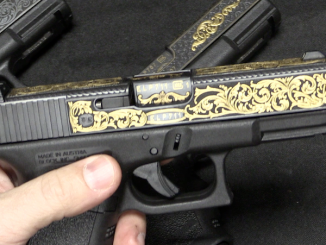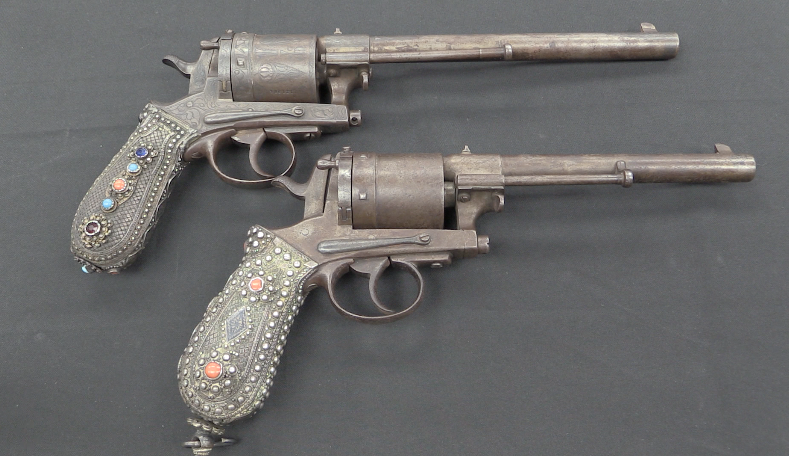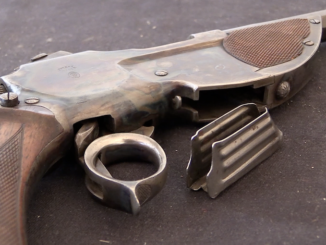Josef Laumann was an Austrian designer of early ring-trigger manually repeating pistols, and was one of the first to develop that type of handgun into a semiautomatic. He took an 1891 pattern ring trigger gun and adapted it with an 1892 patent into a simple blowback self-loader – coming very close to being the first self-loading pistol actually built in the process (although he was just beaten out by the Salvator-Dormus).
He continued to refine the design with the financial aid of the Schonberger brothers, who were his financiers in the endeavor. With their assistance, he produced two patterns of 1894 semiauto pistol, although neither would prove successful enough to see substantial production.
I have the great opportunity today to bring you both an 1891 ring-trigger Laumann as well as examples of both the first and second pattern 1894 Schonberger-Laumann semiautos!




I can imagine that much of the race to get magazine fed pistols to work can be satirized to the song “Stop the Pigeon.” On the one hand, magazine fed pistols can be quick and easy to load assuming that the magazine can be loaded by charger (development before detachable magazines would require en-bloc or strip chargers). On the other hand, more cartridge development is required as (per Daweo input) revolver friendly rimmed cartridges aren’t good for box magazines and tend to make loading the magazine very awkward. How does one load the chamber? Do you need a safety catch? And just how do you craft the receiver/bolt carrier assembly before the Colt 1900 integral bolt/slide setup?
Did I mess up?
A lot of early self-loading pistol designers drew inspiration from bolt-action or even lever-action rifle systems. The Schonberger repeating pistol is basically a Colt-Burgess type lever action, except with a striker driven by an internal spring instead of an external hammer.
Some early self-loader designs even used tubular magazines to allow the use of conventional rimmed revolver type rounds. The Clair pistol of 1893 uses this, coupling it with gas operation;
https://www.forgottenweapons.com/clair-automatic-pistol/
Probably the biggest handicap to the acceptance of the self-loading handgun, though, at least in military circles, was the idea that a soldier (who was of course a mean, panicky animal according to high-ranking officers and politicians) could not be trusted with a rapid-fire, quickly-reloadable weapon because he would waste ammunition;
So there was a lot of “sales resistance” to the self-loading pistol, just as there had been to the repeating rifle and even the breechloading single shot and the Rifle-musket before that. If a lot of the “wiser heads” of European (and even American, like Craig and Ripley) ordnance procurement had had their way in the 19th Century, World War One would probably have been fought very much like Waterloo.
Complete to scarlet facings, Brown Bess muskets, smoothbore six-pounders, and firing by ranks, in the open, at fifty yards.
cheers
eon
Line infantry was proven a thing of the past by the Prussians. The Dreyse rifle stymied the spirited bayonet charge if we use equal numbers of soldiers on both teams. To add insult to injury in your scenario, what would happen if a “non-traditional” team showed up with a platoon of Japanese Type 94 tankettes which would then machine-gun the six-pounder crews to death after having trampled the infantry line to mush? SAY SOMETHING!
Are you drunk?
He’s just pointing out that the military establishment was regressive and obstructionist…
If I were intoxicated by alcohol there wouldn’t even have been any post. I had been under plenty of work stress yesterday and didn’t phrase the post very well.
And according to obstructive traditionalists, there are no such things as proper armies who win by disobeying the rules of tradition. Therefore if a particular state army decided to disobey Napoleonic military social norms by means of issuing repeating breech-loading small arms, breech-loading quick-firing artillery, and perhaps developing armored vehicles along with fixed-wing aircraft, said army would have a great advantage over the traditionalists and likely would hammer them into the ground. FYI, traditionalists tended sabotage progress by using political influence and by appealing to the heroic standards that a man could overcome any machine no matter what happened. Well, sometimes they rigged breech-loading small arms to become unreliable, inaccurate, or dangerous to shoot by removing a few parts without the inventor knowing. And then there was probably a case when the traditionalists literally assassinated a gunmaker just to stop him from making further progress and to scare everyone else into compliance with traditionalist thinking. Either that or I’m thinking of Qing Dynasty China, when the dowager empress burned her son’s imported model train set just to force him to comply with tradition. If ammo conservation was your top priority then I suppose guns should never have been invented! Did I mess up?
“sometimes they rigged breech-loading small arms to become unreliable, inaccurate, or dangerous to shoot by removing a few parts without the inventor knowing.”
This reminded about Luddites group:
https://en.wikipedia.org/wiki/Luddite
though in this case, it was motivated economically rather than ideologically
CD is actually saying by a bit of hyperbole that holding to a paradigm of what is “proper” only works if both sides agree to abide by the rules.
In fact, the Franco-Prussian war was a case in point, in that the French “agreed” to fight by roughly the same rules as the Prussians, who had already beaten two other Continental military powers (Austria-Hungary and Denmark) by those same “rules” in the previous decade.
Among their “rule adherences” was refusing an offer of literally thousands of Spencer carbines and rifles plus millions of rounds of ammunition, as well as Gatling guns chambering the .50-70 cartridge and millions of rounds for them as well.
These were on offer from Dr. Richard Gatling, acting as sales rep for Oliver Winchester, who having bought out both Spencer and the Burnside Rifle Co. (which made Spencers from early 1864 to the end of the American Civil War), plus most of the available stock of .50-70 Gatlings (which the U.S. Army had already replaced with ones chambering .45-70), wanted to dispose of his “surplus” stock where it wouldn’t affect sales of his new Model 1866 Winchester.
The French General Staff said that (1) they had no need of the Gatling due to their own “superior” Montigny Mitrailleuse (similar to the Vandenberg Volley Gun over here), and (2) their own Chassepot needle rifle was superior to the Prussian Dreyse, so they had no need of the “impractical” Spencer.
Gatling also reported back to his boss that the French GS had an odd habit of marching troops back and forth across France for no readily apparent reason. As well as marching them alongside railway RoWs being used by goods trains moving back and forth while nearly empty.
When Gatling commented that in the ACW, the Union had made extensive use of railways to move troops rapidly, the response from one French general was, “The French soldier knows how to MARCH, unlike you soft Americans!”
For an example of similar French obstructionism being repeated in later generations, see The Guns 1914-18 by Ian Hogg (Ballantine Illustrated History of the Violent Century, 1971), which describes the problems the United States Army had with the French Military Mission “reorganizing” things with the AEF and the American arms industry their way from 1916 to 1918.
Another good source is Victory Through Air Power(1942) by Alexander P. De Seversky;
https://en.wikipedia.org/wiki/Victory_Through_Air_Power
He tried to sell the Curtiss Hawk 75A-2 (aka P-36A) to the French in 1938, only to be sabotaged at every turn by the French Air Force staff, who even ordered their test pilots to deliberately keep the Hawk below the performance of their own prototypes at all times to ensure that it was not procured. Because “French aircraft must be seen as inherently superior”, as one pilot told him while apologizing (privately and OTR) for the dog and pony show. By the end, de Seversky pretty much concluded that the French would rather be conquered than admit that they were anything less than prefect in every way.
The relevant chapters have to be read, because there is no way to reproduce the sheer intensity of de Seversky’s scathing analysis of French military “thought”.
Taken altogether, this may explain why France has a bad habit of losing wars. And on the rare occasion that they win one (with outside help), immediately set about creating the conditions that result in the next one (see “Treaty of Versailles 1919”).
cheers
eon
“concluded that the French would rather be conquered than admit that they were anything less than prefect in every way.”
Note that France bought foreign combat aeroplanes – Douglas DB-7:
https://en.wikipedia.org/wiki/Douglas_A-20_Havoc
some were delivered and took part in May 1940 combat.
This aeroplane (differing from version to version) proved be successful in Soviet service, where it was commonly known as Бостон (Boston)
The French Air Force did end up buying Hawks in early 1940, with most ending up in the RAF inventory after the fall of France in June of that year.
Those that did reach the squadrons before the surrender destroyed more Luftwaffe aircraft in the air and on the ground than all other French fighter types combined. Of 24 French airmen who “made ace” in the Battle of France, all flew Hawks doing it.
Ironically, by that time, the Hawk was considered obsolescent over here, having been superseded by the more powerful inline-engined Hawk Model 81, AKA the P-40.
cheers
eon
“what would happen if a “non-traditional” team showed up with a platoon of Japanese Type 94 tankettes which would then machine-gun the six-pounder crews to death after having trampled the infantry line to mush? SAY SOMETHING!”
At first glance it might looks that team mechanized will win, without much effort, but there are examples that effort will be needed; see for example Guerra d’Etiopia (1935-1936):
https://en.wikipedia.org/wiki/Second_Italo-Ethiopian_War
True, at which point the issue is which side has better logistics and training. If the tankettes have better coordination and can prevent the possibility of getting bogged down, the muzzle-loading cannons and infantry lines are dead. If the traditionalist general gets replaced by a commanding officer with better critical thinking skills and adaptability, the armored vehicles will be toasted… lots of Italian tanks were lost to stupidity and lack of spare parts… or am I wrong?
“So there was a lot of “sales resistance” to the self-loading pistol, just as there had been to the repeating rifle and even the breechloading single shot and the Rifle-musket before that. If a lot of the “wiser heads” of European (and even American, like Craig and Ripley) ordnance procurement had had their way in the 19th Century, World War One would probably have been fought very much like Waterloo.”
I want to add beyond problem of it would be ammo-waste!, another prejudice against detachable magazines was that it can be lost, as evidence by fact that Lee-Metford rifles were attached to detachable magazines via chain.
Even today, you can see similar mentalities at work, and not just in the military. In his book The Dilbert Principle</em., Scott Adams relates an anecdote about a company that bought laptop computers for all their sales reps, then bolted them to the reps' desks right next to their PCs. For reasons of "loss prevention".
I guess the reps were supposed to take detailed notes with pencil and paper while on sales calls and then transcribe the notes into the laptops, and then network them to the PCs.
Military command structures have never had a monopoly on the inability to see a forest because of "all those trees in the way".
cheers
eon
This is the US patent of this extra ordinary piece; https://docs.google.com/viewer?url=patentimages.storage.googleapis.com/pdfs/US534894.pdf
This gun was first patented in France in April 4, 1890 and very interestingly, the author, Joseph Laumann states, the main aim of the embodiment is to reduce or zero the felt recoil rather than to load the gun automaticaly.
In fact, patent also reveals the first lever delayed blowback action with a difference that the piece to be accerelated by this lever being a spring forced firing pin rather than a big solid mass used in the current productions
A mind blowing invention. Hats off Herr Laumann and much thanks to Ian for this
video.
It should be stated that, for common lever delay understanding, the accelarator lever should be the one on the breechbolt and the big one mounted over the frame, should be “The actuator” for this lever. IMHO.
You can always tell an expert! Thanks for conritbuting.
Glad these comments have veered back to the pistol at hand. I don’t know where Mr. M was when he shot this video, but presumably his copy of Ezell’s “Handguns of the World” was not near at hand. In there, Ezell quotes Wilson estimating the muzzle velocity as approximately 325 m/second (1,065 fps), and states (with reproductions of the patent drawings) that the gun was not a blowback, nor a delayed blowback (Sorry Mr. S), but a locked-breech pistol! The unlocking was actuated by the unique system of the CARTRIDGE PRIMER CAP pushing back on the firing pin, in turn unlocking the lever (in fact described in the patent as a “locking bar”) holding the breech closed. (Though the US patent seems not to mention the primer cap impinging on the firing pin.) If the lever (“locking bar”) acted also as a brake on the breech block’s opening, I suppose we may have some kind of locked-breech delayed-recoil combo here.
I am amazed Mr. M missed or forgot this, as every reference I ever read about the “Schoenberger” mentioned its unique primer-actuated unlocking mechanism and internal complexity. If Mr. Ezell is right about this mechanism, then I suppose Salvator and Dormus get the prize not just for first automatic pistol but first delayed-blowback. I mention all this in justice to history, toward getting a correct record here. If anyone has some further information to add I would be glad to see it.
Thanks for your interesting information. Appearently patent images gives no clue for “Primer Actuated Breech Lock”. Besides, “Locking Bar” seems having ability to give motion to the firing pin but, not vice versa. Further, if the contact face of locking bar is just in upright angle with its axis, there seems no possibility to get motion from any parts at instant of firing in the locked breech, the system seems motionless in through firing sequence. should the pistol had worked with the given lay out, there should be a slight downward angle at receiver recess being contact with locking bar or the given moving tolerances could provide such a gap, or unplanned inertial mass motions should cause a rearward motion at the cocking lever resulting a slight motion on the locking bar, or I could not get sufficient influence into the description written in the patent text. IMHO.